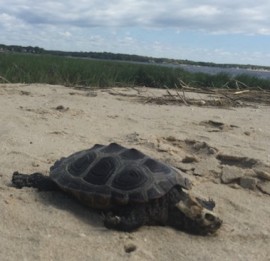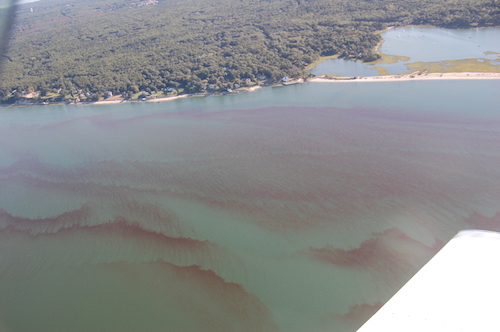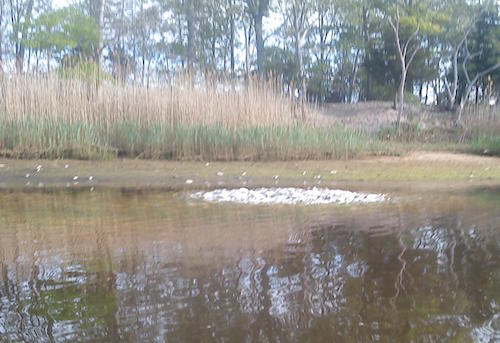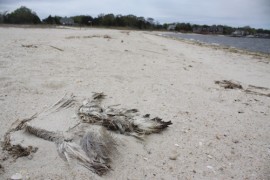As dead turtles wash up on Flanders Bay beaches by the hundreds, officials and marine scientists have been scrambling to determine what’s killing them – and to investigate any possible connection to the recent deaths of other marine wildlife.
Thousands of dead bunker and at least three dead sea birds have also been found in the same vicinity as the diamondback terrapin turtles, suggesting that whatever is killing the turtles may have more wide-ranging, alarming consequences.
In water samples taken last week, marine scientists measured the highest ever recorded levels of a lethal toxin in Meetinghouse Creek, which flows into Flanders Bay. But lab tests on dead terrapin collected by the New York Department of Environmental Conservation have not yet confirmed if that toxin is in fact the culprit in the mass turtle die-off.
The diamondback terrapin turtles began washing ashore in late April, as first reported by RiverheadLOCAL on May 13. Their bodies were “in perfect condition,” according to Karen Testa, executive director of Turtle Rescue of the Hamptons. She has been collecting the bodies and sending them to Cornell University’s Wildlife Health Program to be necropsied.
“It was a horrendous sight,” she said in an interview last week. “All those animals just washed up on the beach.”
The DEC has also collected dead turtles from the Flanders Bay area and, in conjunction with Cornell, has been searching for the presence of the marine toxin saxitoxin in its samples to determine if that could be the cause of death.
Three local creeks and western Shinnecock Bay have been closed to all shellfish harvesting in recent weeks due to high levels of this toxin. Many local waterbodies, including a western portion of Flanders Bay, are already uncertified for shellfish harvesting for sanitary reasons.
But saxitoxin is responsible for paralytic shellfish poisoning when consumed by humans, which can cause numbness or tingling in the face or limbs, and —in very serious cases — death. The Suffolk County health department on Saturday issued a warning against eating shellfish taken from these areas.
In the most recent samples taken on Friday, May 15, saxitoxin levels in shellfish from Meetinghouse Creek were the highest ever measured, and 10 times higher than usual, said Christopher Gobler, associate dean of research at Stony Brook University’s School of Marine and Atmospheric Sciences. Gobler conducted the research with the Suffolk County Department of Health Services.
Saxitoxin has not been found in Flanders Bay, which was not included in the DEC’s recent emergency closures. However, there have been high levels of the “red tide” algal bloom that produces saxitoxin in Flanders Bay and its tributaries all month, Gobler said.
The highest levels of the red tide bloom, called Alexandrium, were found in Meetinghouse Creek in the vicinity where most of the dead turtles have been found, he said.

Shellfish are a big part of the terrapin’s diet, but it is unclear whether the ingestion of these toxic shellfish are actually causing the turtle deaths. Lab tests on turtle bodies by the DEC have not turned up any answers so far, according to Severino.
Scientists pooled intestine contents together from three terrapin turtles collected from Flanders Bay to test for saxitoxin. Results suggested saxitoxin may have been present, but they were inconclusive.
“The finding in stomach contents may only mean that they incidentally ingested contaminated material shortly before death, and not that they died from saxitoxin,” Severino said. “Better evidence is needed before we can confirm the toxin.”
In addition, the area’s turtles have survived dcades’ worth of algal blooms in Flanders Bay. “It’s almost an annual occurrence now with some kind of algae bloom,” said Kevin McAllister, former head of the Peconic Baykeeper organization and founder of Defend H20.
And though the algal bloom caused by Alexandrium, the red tide, is more lethal to marine life than rust tides or brown tides, a terrapin turtle die-off from a red tide is almost unheard of.
“Turtles are not typically reported to be affected by saxitoxins in areas of Alexandrium blooms,” biochemistry Prof. Gian Paolo Rossini at the University of Modena, writes in his textbook on toxic algae.
A number of fish, shellfish and other marine wildlife, however, have been found to be adversely affected by Alexandrium, according to the National Oceanic and Atmospheric Administration Center. These include both menhaden, more commonly known as bunker, which feed on algae, and sea birds, which feed on bunker.
 Beginning last week, there have been reports of thousands of dead bunker in Meetinghouse Creek and nearby Simmons Point.
Beginning last week, there have been reports of thousands of dead bunker in Meetinghouse Creek and nearby Simmons Point.
“I was kayaking out there [Sunday] and there were tons and tons of dead fish floating over the top of the water,” said Aquebogue resident Maria Orlando Pietromonaco, who lives near Simmons Point on Flanders Bay.
Die-offs of bunker are not uncommon, especially in high summer when temperatures are high and oxygen levels are low in local waterbodies. “But when you’ve got all these turtles washing up, along with a large die-off of bunker, that’s something you need to take into account,” McAllister said.

While walking along Simmons Point last week, Pietromonaco and her children also discovered the bodies of eight turtles and three different large sea birds that resembled osprey – all in the same general vicinity.
The carcasses of the sea birds were too decomposed to know for sure, she said.
“I’ve been going to this beach almost 50 years, and I’ve never seen anything like it before,” she said.
The DEC has hired two wildlife technicians this year to survey diamondback terrapins habitat areas and to develop a better estimate of their population numbers. Though New York does not give terrapins any special conservation status, terrapins are an endangered species in Rhode Island, a threatened species in Massachusetts and a species of special concern in six other states.
Meanwhile, the DEC and Cornell University will continue testing the tissues on the turtles they collected from Flanders Bay. It will be between two to three weeks before any additional information is available, the DEC says.
The survival of local journalism depends on your support.
We are a small family-owned operation. You rely on us to stay informed, and we depend on you to make our work possible. Just a few dollars can help us continue to bring this important service to our community.
Support RiverheadLOCAL today.






























